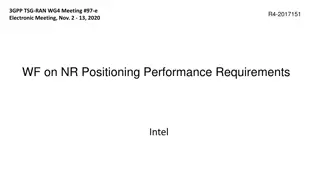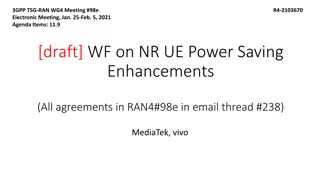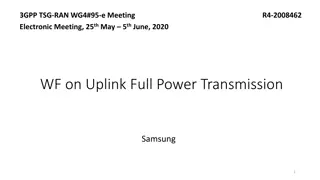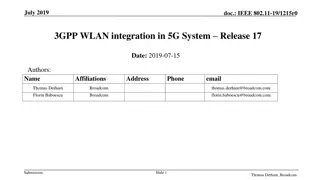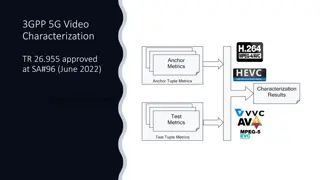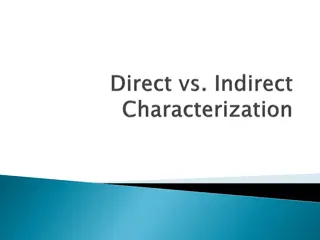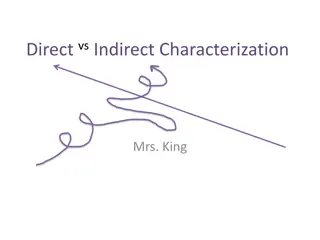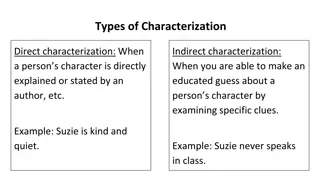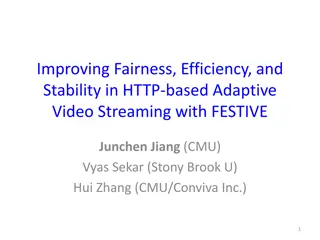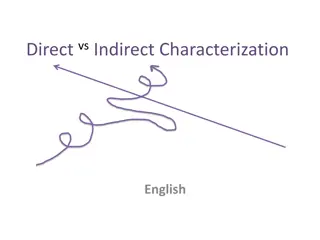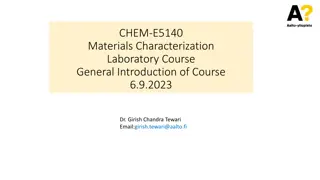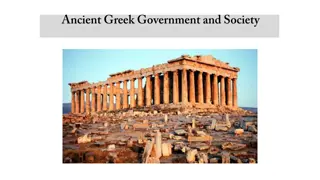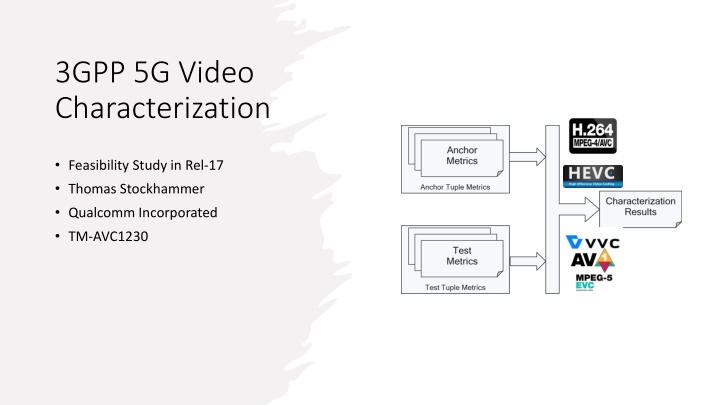
5G Video Codec Characterization Study in Rel-17: Feasibility Analysis by Thomas Stockhammer at Qualcomm
Explore the feasibility of characterizing video codecs for 5G services in Rel-17, focusing on H.264/AVC and H.265/HEVC as benchmarks. Objectives include identifying interoperability requirements, performance characteristics, and implementation constraints. Scenarios like Full HD Streaming, 4K-TV, Screen Content, Messaging and Social Sharing, and Online Gaming are analyzed, with a new scenario for 8K in progress.
Download Presentation

Please find below an Image/Link to download the presentation.
The content on the website is provided AS IS for your information and personal use only. It may not be sold, licensed, or shared on other websites without obtaining consent from the author. If you encounter any issues during the download, it is possible that the publisher has removed the file from their server.
You are allowed to download the files provided on this website for personal or commercial use, subject to the condition that they are used lawfully. All files are the property of their respective owners.
The content on the website is provided AS IS for your information and personal use only. It may not be sold, licensed, or shared on other websites without obtaining consent from the author.
E N D
Presentation Transcript
3GPP 5G Video Characterization Feasibility Study in Rel-17 Thomas Stockhammer Qualcomm Incorporated TM-AVC1230
Approved in by SA plenary #87 in SP-200052. High-Level Objectives identify relevant interoperability requirements, performance characteristics and implementation constraints of video codecs in 5G services, characterize existing 3GPP video codecs, in particular H.264/AVC and H.265/HEVC as benchmark for the addition of potential future video codecs. The concrete objectives are as follows: Collect a subset of relevant scenarios for video codecs in 5G-based services and applications, including video formats (resolution, frame rates, color space, etc.), encoding and decoding requirements, adaptive streaming requirements, predominantly based on scenarios defined for 5G media streaming as well as for TR 26.925 and TR 26.928. Collect relevant and exemplary test conditions and material for such scenarios, including test sequences. Scope Define performance metrics for such scenarios with focus on objective performance metrics. Collect relevant interoperability functionalities and enabling elements for video codecs in different 5G services such as MTSI and Telepresence (i.e. RTP based conversational communications), or 5G media streaming (e.g. based on DASH/CMAF) supporting the identified scenarios. Collect relevant criteria and key performance indicators for the integration of video codecs in 5G processing platforms, taking into account factors such as encoding and decoding complexity in the context of the defined scenarios. Characterize the existing codecs H.264/AVC and H.265/HEVC in the context of the above scenarios and document the findings in a consistent manner. Identify gaps and deficiencies of existing codecs in such use cases and derive requirements for potential new codecs. Collect initial information on how new codecs under development in ISO/IEC SC29 WG11 (MPEG)/JVET (in particular including VVC and EVC) may meet the above criteria based on the characterization results provided for example by ISO/IEC SC29 WG11 (MPEG)/JVET.
S4-210871 S4-210871 The latest version of TR26.955 is available in S4- 210871 in version 1.2.0. This document collects the status of the work and identifies the open points. S4-210956 Also note that the work item has been updated in S4-210956 which will be sent to SA for approval (adds AV1) Status after SA4#114-e S4-210741 The time plan is available in S4-210741 (Completion Dec 2021) A status update as well as tracking open issues is provided in S4-210872 S4-210872
Scenarios are defined to identify how video codecs are typically used in 5G type of services To define reference sequences (types and formats), decoding & encoding constraints Defined Scenarios Scenario 1: Full HD Streaming Scenario 2: 4K-TV Scenario 3: Screen Content Scenario Scenario 4: Messaging and Social Sharing Scenario 5: Online Gaming Note: New scenario will be added for 8K based on new work item Scenarios
Anchor Generation for each Scenario Anchor Configuration Reference Software Conforming Anchor Bitstream Anchor Sequence Reference Sequence Decoder Encoder Metrics Computation Anchor Metrics
Reference Sequences: Example 4K-TV Key S2-R1 S2-R2 S2-R3 S2-R4 S2-R5 S2-R6 S2-R7 S2-R8 Name Brest-Sedof Rain Fruits Park Joy Soccer Tunnel Flag Boat Fountain Riverbank Reference Annex C.3.1.3.1 Annex C.3.1.3.2 Annex C.3.1.3.3 Annex C.3.1.3.4 Annex C.3.1.3.5 Annex C.3.1.3.6 Annex C.3.1.3.7 Annex C.3.1.3.8 Resolution 3840 x 2160 3840 x 2160 3840 x 2160 3840 x 2160 4096 x 2160 4096 x 2160 4096 x 2160 3840 x 2160 Frame rate 60 50 50 23.98 59.94 59.94 59.94 50 Colour Gamut BT.709 BT.709 BT.709 BT.709 BT.709 BT.709 BT.709 BT.709 Number of Frames 300 500 500 385 600 300 600 600 Scene Cut 0 0 0 4 0 0 0 0 Key Name Reference Resolution Frame rate Colour Gamut Number of Frames Scene Cut S2-R11 Life-Untouched Annex C.3.2.3.1 4096 x 2160 59.94 BT.2020 450 0 S2-R12 Meridian Annex C.3.2.3.2 3840 x 2160 59.94 BT.2020 0 327 S2-R13 Sol-Levante Annex C.3.2.3.3 3840 x 2160 24 BT.2020 0 145 S2-R14 Cosmos Annex C.3.2.3.4 3840 x 2160 24 BT.2020 0 182 432 S2-R15 Elevator Annex C.3.2.3.5 4096 x 2160 59.94 BT.2020 0 S2-R16 Sparks Annex C.3.2.3.6 4096 x 2160 59.94 BT.2020 261 0 S2-R17 Nocturne Annex C.3.2.3.7 3840 x 2160 BT.2020 0 60 370 All sequences are available here https://dash-large-files.akamaized.net/WAVE/3GPP/5GVideo/ReferenceSequences/ Example annotation https://dash-large-files.akamaized.net/WAVE/3GPP/5GVideo/ReferenceSequences/Brest-Sedof/Brest-Sedof.json
Metrics SDR & HDR Name parameter bitrate Type BIGINT DOUBLEPRECISION Semantics the associated variation parameter as defined for the anchor, for example the QP The size of the file divided by the duration of the reference sequence in bit/s as defined in clause 5.5.1 with 2 decimal digits accuracy. Peak signal to noise ratio for Y planes in dB as defined in clause 5.5.2 with 2 decimal digits accuracy. y_psnr u_psnr v_psnr ms_ssim vmaf bitrate_log encode_time decode_time DOUBLEPRECISION DOUBLEPRECISION DOUBLEPRECISION DOUBLEPRECISION DOUBLEPRECISION DOUBLEPRECISION DOUBLEPRECISION DOUBLEPRECISION Peak signal to noise ratio for U planes in dB as defined in clause 5.5.2 with 2 decimal digits accuracy. Peak signal to noise ratio for V planes in dB as defined in clause 5.5.2 with 2 decimal digits accuracy. structural similarity between frames as defined in clause 5.5.2 with 4 decimal digits accuracy. Video Multimethod Assessment Fusion (VMAF) as defined in clause 5.5.2 with 2 decimal digits accuracy. The bitrate as documented by the encoder log. If not known, it is set to 0. Total time spent to encode the sequence with reference encoder in seconds. If not known, it is set to 0. Total time spent to decode the sequence with reference decoder in seconds. If not known, it is set to 0. Name Parameter Bitrate y_psnr u_psnr v_psnr Wpsnr psnrl100 de100 bitrate_log encode_time Type BIGINT DOUBLEPRECISION DOUBLEPRECISION DOUBLEPRECISION DOUBLEPRECISION DOUBLEPRECISION DOUBLEPRECISION DOUBLEPRECISION DOUBLEPRECISION DOUBLEPRECISION Semantics the associated variation parameter as defined for the anchor, for example the QP The size of the file divided by the duration of the reference sequence in bit/s as defined in clause 5.5.1. Peak signal to noise ratio for Y planes in dB as defined in clause 5.5.2. Peak signal to noise ratio for U planes in dB as defined in clause 5.5.2. Peak signal to noise ratio for V planes in dB as defined in clause 5.5.2. Weighted peak signal to noise ratio for Y, U and V planes in dB as defined in clause 5.5.3. PSNRL100 as defined in clause 5.5.3 DE100 as defined in clause 5.5.3. The bitrate as documented by the encoder log. If not known, it is set to 0. Total time spent to encode the sequence with reference encoder in seconds. If not known, it is set to 0.
Metrics Details Anchor Configuration Reference Software Anchor Bitstream Anchor Sequence Reference Sequence Conforming Decoder Encoder json json json Metrics Computation Anchor Metrics
Tools Unix command for file size Reference Encoders Reference Decoders HDRTools HDRConvert (bitdepth, YUV/RGB for HDR) HDRMetrics vmafossexec Others?
Open Questions and Proposal for SDR Metrics We need definitions for each of the metrics that can be implemented MS-SSIM 10 bit basis Needs conversion of 8 bit to 10 bit in two steps Use MPEG definition (unless someone complains) in dB VMAF 10 bit only (unclear internally) Needs conversion of 8 bit to 10 bit in two steps Bitrate Options Bitstream File size (AVC, AV1) File size frames*sizeSEI*flag General processing model Per codec processing model (file size w/o hash SEI for HEVC, VVC, EVC?) Per codec/cfg processing model Encoder log (expect identical with above) File size is only tracked for debugging PSNR 10 bit basis for all sequences (max 1020) We need algorithm for I: 8 bit -> O: 8 bit (AVC) I: 8 bit -> O: 10 bit (HEVC) I: 10 bit -> O: 10 bit (HEVC) 8 bit to 10 bit convert by adding 2 '0 s One step preferred Two step is currently done
Open Questions and Proposal for HDR Metrics Bitrate same as SDR PSNR same as SDR (all 10 bit) HDR Specific Metrics Wpsnr psnrl100 De100 Process 10 bit yuv => 4:2:0 => 4:4:4 => RGB floating point => compute HDR metrics Desirable is a one step Currently a two-step approach: HDRConvert + HDRMetrics If used we would apply single precision for EXR Alexis will check if one step is doable, otherwise we go with two-step
Verification Anchor bitstream verification: Anchor bitstreams are correct. By using a defined reference sequence, an anchor configuration as well as a reference encoder, two different executions of this process results in the same anchor bitstream. Anchor reconstruction is correct. By using a verified anchor bitstream, a reference decoder in two different implementations results in the same anchor sequence, in the same quality metrics.
Characterization Characterization is the comparison of a codec under test with an anchor based on the framework introduced in this clause. Characterization in this report is based on Bj ntegard-Delta (BD)-rate. A full characterization of a codec for a scenario against a 3GPP codec shall provide at least the following metrics The BD-rate gain for each defined anchor tuple and each required metric The average BD-rate gain across all anchors of the scenario for each required metric.
Tools and Repositories All sequences are available here https://dash-large- files.akamaized.net/WAVE/3GPP/5GVideo/ReferenceSe quences/ All metrics, anchors and tests are available here: https://dash-large- files.akamaized.net/WAVE/3GPP/5GVideo/Bitstreams/ Scripts for running anchor and test generation, metrics generation as well as verification is provided here: https://github.com/haudiobe/5GVideo/




